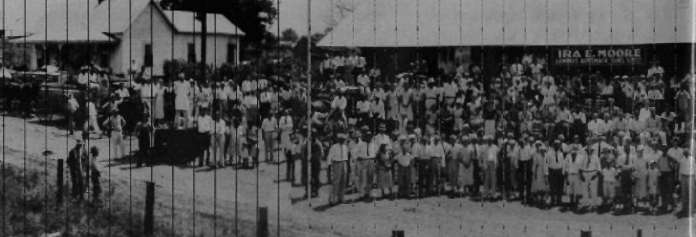Since its earliest settlement through the World War II era, cotton was an
important Cash crop in the area where Rison developed. Although not as fertile
as in the Delta, the land around Rison was suitable for production of upland
short staple cotton. Most of the farming of the area was of a subsistence
nature. Small farmers produced most of what they needed and grew cotton for
its Cash value to purchase items they could not produce an their farms. However,
many landowners, especially those with large holdings, participated in the
cotton market economy by utilizing the sharecropper and rental System.
Consequently, Rison became a lively, Small scale marketing Center for cotton.
Some of the landowners also operated cotton gros and required their sharecroppers
and tenants to use their gros to haue the cotton baled and ready for sale.
At one time or another, there were three cotton gros in or around Rison:
Rison Gin Company, Farmers Gin and Seed Company, and Moores Gin,
|
owned by LE. Moore.
During the cotton picking and ginning season, which started in August and
lasted through Thanksgiving, it was typical to See long lines of wagons waiting
patiently to haue the cotton vacuumed out of the wagons and fed into the
ginning machinery. Most of the wagons had high side boards and carried 1,400
to 1,500 pounds of freshly picked cotton. After the ginning was completed,
the bales which usually weighed 400 to 500 pounds were loaded an the wagon
at the other end of the gin together with the cotton seed which was blown
loose into the wagon. The finished bale and the seed were then driven to
a warehouse where the bale and seed were unloaded and the cotton grower and
the landowner settled their accounts. It was customary for the landowner
to "furnish'' the sharecropper or tenant goods necessary for the family to
live an until the cotton was harvested and Sold. The "furnish" was actually
a credit system usually at a Store owned by the Land holder. When the
|
accounts were settled what was left was paid to the sharecropper or tenant
in cash. Many times the value of the cotton was not enough for the tenant
to "pay out" and the cycle began again. In the good years the fall season
was one of much hustle and bustle. The family had money for new things, so
the entire family looked forward to the trips to the gin. The children were
always excited at this time. School was starting and the county fair and
a carnival was in town. People who had not Seen each other through the summer
months were able to renew old acquaintances and swap Stories about their
summer experiences. Undoubtedly many new romances were begun at this time.
By the 1920's with the coming of automobiles, the telephone, the radio and
moving pictures much of the Luster of the fall cotton season began to fade.
However, many Small communities such as Rison still hold county fairs and
offer some entertainment in the fall season.
|
![]() Seite 13 / page 13 of
24
Seite 13 / page 13 of
24![]() zurück / back home
zurück / back home

![]() Seite 13 / page 13 of
24
Seite 13 / page 13 of
24![]() page
1
page
1
![]() 2
2
![]() Index
Index
![]() 3
3
![]() 4
4
![]() 5
5
![]() 6
6
![]() 7
7
![]() 8
8
![]() 9
9
![]() 10
10
![]() 11
11
![]() 12
12
![]() 13
13
![]() 14
14
![]() 15
15
![]() 16
16
![]() 17
17
![]() 18
18
![]() 19
19
![]() 20
20
![]() 21
21
![]() 22
22
![]() 23
23
![]() 24
24
![]() zurück / back home
zurück / back home